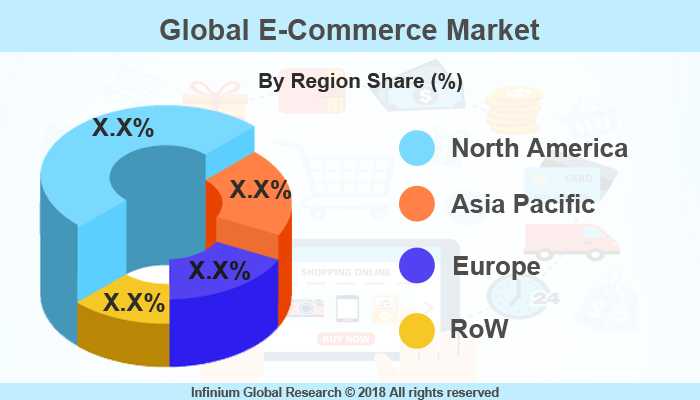E-Commerce Market (Shopping Category - Electronics, TV & Appliances, Home & Furniture, Fashion, Gaming & Books and Beauty & Health Supplies; Business Model - B To B and B To C; Payment Type - Net Banking, Credit Card, Debit Card, Wallet, and COD): Global Industry Analysis, Trends, Size, Share and Forecasts to 2024
A recent report published by Infinium Global Research on e-commerce market provides an in-depth analysis of segments and sub-segments in global as well as regional e-commerce market. The study also highlights the impact of drivers, restraints and macro indicators on the global and regional e-commerce market over the short term as well as long term. The report is a comprehensive presentation of trends, forecast and dollar values of the global e-commerce market. According to the report, the global e-commerce market is projected to grow at a healthy CAGR over the forecast period of 2018-2024.
Market Insight
E-commerce is the activity of buying or selling of products through online services or over the Internet. E-commerce consist of online goods and services such as software; e-books, marketplace services such as e-wallet, retail services such as ordering foods, and customer support. E-commerce is further classified on the basis of the dealing parties such as B to B, B to C, C to C, and C to B, or through distribution channels adopted by them that includes brick-&-click, pure click, or click-to-brick. Travel & leisure, financial services, e-tailing, digital content, and other well-known online services in the wide range of e-commerce are gathering momentum with enlarged internet use.
Factors driving the growth of e-commerce market includes decreasing the cost of communication, infrastructure, and another related cost, and also, the use of e-commerce that helps in speeding up in the transactions by removing many unwanted intermediaries. Furthermore, customer interaction, customer interaction and marketing forces boost the e-commerce market. In addition to this, women preferring online shopping and augmented impact of social networking on society is fueling the growth of this market. Increasing internet penetration, better economic performance, the rise in digital literacy, an increase in awareness about the benefits of online trading are some of the factors that are increasing the market growth.
Shopping websites permit the consumers to create multiple payment options with the help of debit and credit cards, net banking, electronic wallets, cash on delivery and cryptocurrency that provides convenience to users for the payment of the products. It also helps in tracking the consumer’s loyalty, as several e-commerce companies are introducing various incentives such as free shipping to customers, free exchange and return policies to grow their brand proposal and this results in the growth of e-commerce market. One of the latest trend observed in the e-commerce market is social media advertising. This not only allows advertisers to use display banner but also sponsor the content to attract the consumers. However, on the flip side, mechanical failures and delay in the supply chain can cause unpredictable effects on the total processes and these factors hamper the growth of the e-commerce market.
Among the geographies, North America is the largest region in the E-commerce market followed by the Asia Pacific. In North America, the growth of this market is due to high-speed internet facilities joint with the well-established supply chain for goods delivery, protected internet transactions and growing consumer awareness regarding the e-commerce market. Factors such as growing mobile internet usage, increasing internet penetration, increase in awareness about the benefits of online trading and trend to adopt Western culture is driving the growth of this market in the Asia Pacific region.

Segment Covered
The report on global e-commerce market covers segments such as shopping category, business model and payment type. On the basis of the shopping category, the global e-commerce market is categorized into electronics, TV& appliances, home & furniture, fashion, gaming & books, and beauty & health supplies. On the basis of the business model, the global e-commerce market is categorized into B to B and B to C. On the basis of payment type the global e-commerce market is categorized into net banking, credit card, debit card, wallet, and cod.
Geographic Coverage
The countries covered in the North America region include the U.S., Canada, and Mexico; while Asia-Pacific includes China, Japan, India, South Korea, Malaysia, and among others. Moreover, Germany, U.K., France, Spain, and Rest of Europe are included in the European region. The U.S. drives the growth in the North America region as it is the largest market in the region. The Asia-pacific region offers substantial potential for the market growth owing to rapid growth in markets such as India and China. The APAC region is projected to experience growth at a CAGR of x.x% over the period of 2018-2024.
Companies Profiled:
The report provides profiles of the companies in the global e-commerce market such as Amazon, Inc., Jingdong, Alibaba Group Holding Ltd., eBay Inc., Rakuten, Inc., B2W Companhia Digital, Zalando, Groupon, Walmart, and Priceline.
Report Highlights:
The report provides deep insights into demand forecasts, market trends, and micro and macro indicators. In addition, this report provides insights into the factors that are driving and restraining the global e-commerce market. Moreover, IGR-Growth Matrix analysis given in the report brings insight into the investment areas that existing or new market players can consider. The report provides insights into the market using analytical tools such as Porter's five forces analysis and DRO analysis of e-commerce market. Moreover, the study highlights current market trends and provides forecast from 2018-2024. We also have highlighted future trends in the e-commerce market that will impact the demand during the forecast period. Moreover, the competitive analysis given in each regional market brings insight into the market share of the leading players. This report will help manufacturers, suppliers, and distributors of the e-commerce market to understand the present and future trends in this market and formulate their strategies accordingly.
